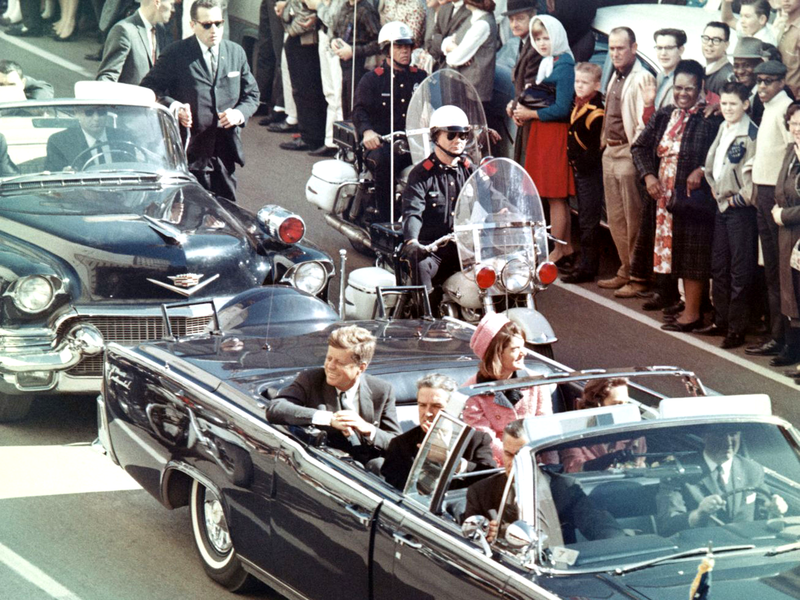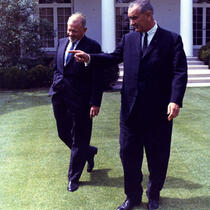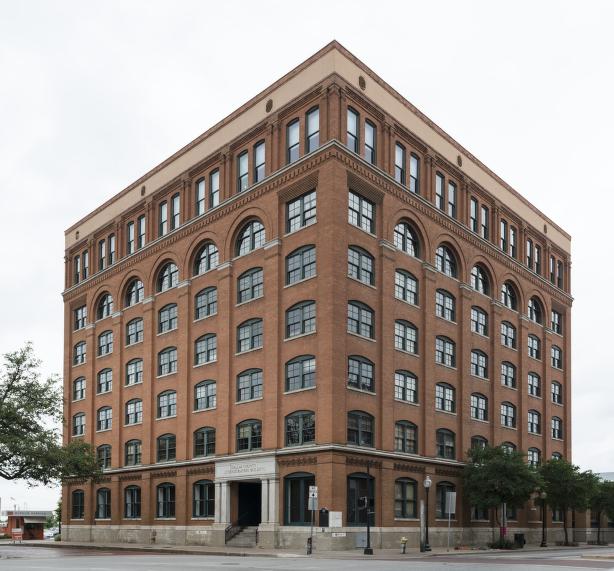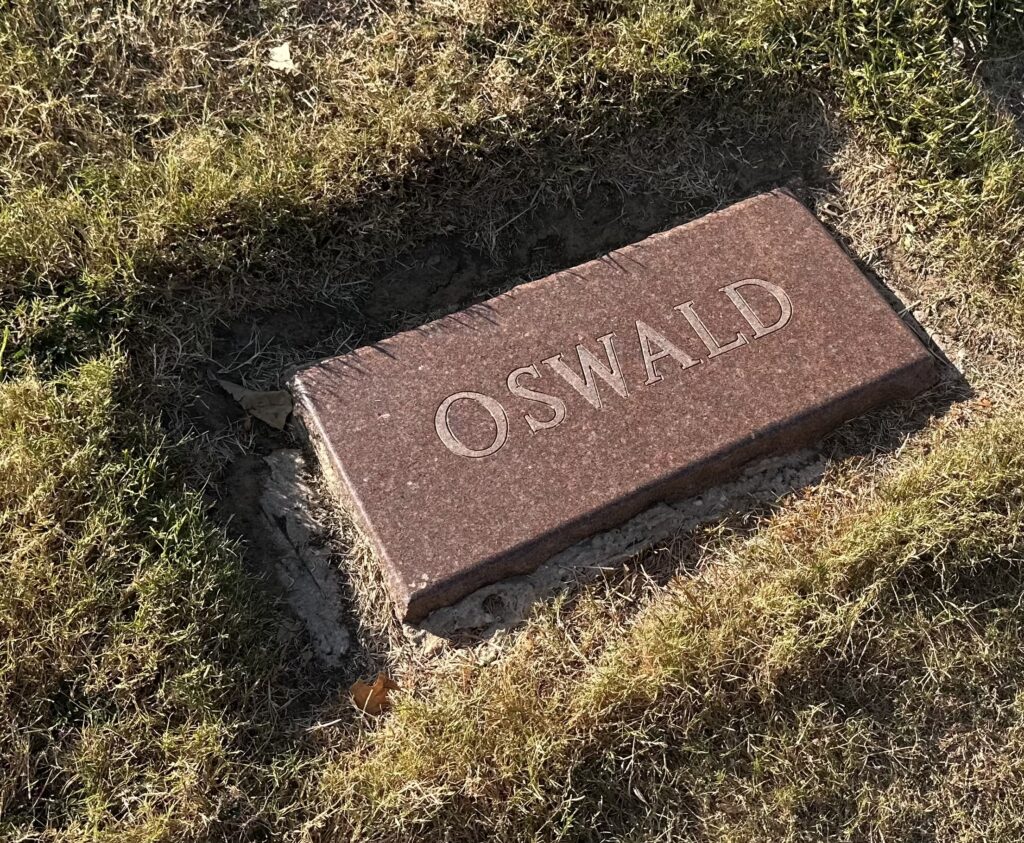While in Dallas, on his Steinbeck Travels with Charley Tour, Clay revisits places and memories connected with President John Kennedy’s tragic assassination on November 22, 1963.

John Steinbeck was an Adlai Stevenson man who came to admire John F. Kennedy. JFK invited the Steinbecks to his inauguration on January 20, 1961. It’s not clear how close they became during the 1,000 days of the Kennedy administration, but John and his third wife, Elaine, dined at the White House several times (always with many other guests).
When Steinbeck passed through Fort Worth/Dallas at the end of November 1960, president-elect Kennedy was assembling the best and the brightest to lead America into what he called a New Frontier. Steinbeck had watched the Nixon-Kennedy debates as he traveled the country that autumn. He was unsure about JFK, but he knew he loathed Richard Milhouse Nixon.
When you take a transcontinental road trip, no matter what its ostensible purpose, there are things you feel compelled to see if you pass through anywhere near their location. For me, Dealey Plaza in Dallas is one of those places. I’ve been there two or three times before, and I wanted to see it again, but also — thanks to a good friend as guide — to follow Lee Harvey Oswald’s trajectory through the day. Not sure why. Maybe it’s because I’ve re-read Manchester’s Death of a President several times in the last year. And Paul Landis’ potentially game-changing memoir, The Final Witness: A Kennedy Secret Service Agent Breaks His Silence after 60 Years.
The assassination of John F. Kennedy on Friday, November 22, 1963, is one of the great pivot moments of American history, along with July 4, 1776, December 7, 1941, September 11, 2001, and — I would add — August 6, 1945, the day the U.S. dropped the atomic bomb on the mostly civilian population of Hiroshima in Japan. As J. Robert Oppenheimer said, “We knew the world would not be the same.”
I am old enough to remember where I was the day President Kennedy was killed. We were a lower-middle-class family at the time, living in a cracker box house in a small cattle town in western North Dakota. We had a big brown box, black and white television set with a rabbit ears antenna, on which we attached sheets of aluminum foil to improve the ghostly image. Led by my father, we solemnly watched television all weekend. This is when I saw my father cry for the first time. I don’t remember much. I don’t believe we saw the killing of Lee Harvey Oswald live, but I know we saw it replayed a dozen times in the next few days. From the day of the funeral, I remember the riderless horse chafing and plunging as its handler strove to keep it moving forward under control in the funeral cortege.
The Steinbecks, JFK and LBJ

When the president died, John and Elaine Steinbeck were in Poland on a U.S. Information Agency (USIA) tour on behalf of the Kennedy administration. They wanted to fly home to the United States, but they reckoned that their duty was to continue the goodwill tour JFK had sent them on to the other side of the Iron Curtain. In Warsaw, Steinbeck wrote a tender letter to Jacqueline Kennedy, followed by a letter of support to the new president, Lyndon Johnson. A few weeks later, Mrs. Kennedy invited Steinbeck to see her in Georgetown when he returned from his travels. John and Elaine visited her in February 1964. It was then that she asked Steinbeck to consider writing the authorized biography of her martyred husband. The great novelist seriously considered taking on the project — mostly out of respect for the slain president and his widow — but within a couple of months, he carefully declined.

Soon enough, Steinbeck became a good friend of LBJ. Elaine had been a student at the University of Texas at Austin at the same time as Claudia Alta (Lady Bird Johnson). The Steinbecks were frequent guests in the LBJ White House. Steinbeck became a staunch supporter of LBJ’s leadership and his political program. In fact, Steinbeck defended Johnson’s handling of the Vietnam War after the big buildup in 1965-66, to the detriment of his reputation as a left-leaning novelist.
Last week, I spent two nights in a village near Fort Worth with several of my most generous (and zany) friends. They took me to my first (their dozenth) Lyle Lovett concert. They took me to the spectacular Amon Carter Museum of American Art and then the Sid Richardson Gallery in downtown Fort Worth, with a brief photo stop in front of the old Fort Worth Hotel, where JFK gave the last speech of his life.
On the second day, Tommy took me on my JFK-Oswald tour.
We started at the Sixth Floor Museum at Dealey Plaza. The exhibits are all helpful and competent. Tommy was frustrated, however, because (perhaps inevitably) the interpretation favors the Lone Gunman Hypothesis and suggests that the case is closed. I mostly wanted to look through the sixth-floor windows down onto Elm Street and imagine the sequence of events between 12:27 and 12:32 p.m. on November 22. All you can say is: plausible.
I’m a Kennedy assassination obsessive of the second rank. Over the years, I have read a few dozen books about the assassination, beginning with Manchester’s magnificent Death of a President (1967), which I have been writing about over the last year. I’ve read all the standard works and some of the fringe stuff. Several years ago, I hosted a public humanities symposium on the 1960s in Bismarck, North Dakota; one long session was on the events of November 22, 1963. So, I know my way around the literature. Most recently, I read Secret Service member Paul Landis’ late-life revelation (The Last Witness) that he tampered with the evidence at Parkland Hospital, lifting what became known as “the magic bullet” from the top of the rear seat in the limo and putting it in his pocket, later to slip it onto the gurney in the hospital.
If this is true — and others, including the Secret Service’s Clint Hill, discount and discredit it — a member of the U.S. Secret Service tampered with the evidence in one of the greatest crimes of the 20th century and didn’t bother to report this massive act of malfeasance until he reached death’s door. If Landis is telling the truth, the strained “magic bullet” theory collapses. There is no mention of Landis’ confession in the Sixth Floor Museum, and his book is not sold in the museum shop — which is altogether disappointing for other reasons.
About a hundred people were on the Sixth Floor as we read the interpretive panels one by one. Almost all of them were born long after the events in question.

Hard Questions
You cannot spend much time on the Sixth Floor without asking a number of hard questions:
-Did Oswald act alone?
-How many shots were fired?
-Is it possible there was a second gunman or several others?
-Why have the American people disbelieved the Warren Commission Report right from the beginning?
-If Oswald was the assassin, what exactly were his motives?
-Was Oswald pro-Cuba (and Castro) or anti-Cuba?
-Was Oswald a Soviet agent of some sort, or was he tainted with Soviet indoctrination?
-Why did Oswald visit Mexico just two months before the assassination?
-When Oswald declared that he was “a patsy,” what did he mean, and should we believe him?
-If it was a conspiracy, who else was involved and for what purpose?
-Why did Jack Ruby kill Oswald at Dallas Police headquarters two days later as he was being transferred from one jail to another?
-Why did FBI director J. Edgar Hoover declare by the end of that chaotic Friday that the assassination was the work of a lone gunman? How could he possibly know?
There is an exceedingly rich literature on these questions. You could spend the rest of your life reading all those books and watching the scores of documentary films on the subject. I suggest Gerald Posner’s Case Closed: Lee Harvey Oswald and the Assassination of JFK; Bill Minutaglio and Steven L. Davis’, Dallas 1963; and Manchester’s Death of a President. I do not recommend Oliver Stone’s fascinating but historically muddling movie, JFK.
And, if you get out from under the cloud of mysteries and unanswered questions and pour yourself a glass of wine at the end of the day, bigger questions begin to drift in:
-How are America and the world different because of the assassination?
-Would Kennedy have wound us up or down in Vietnam?
-Would Kennedy have been able to persuade Congress to pass the Civil Rights bills of 1964 and 1965, or did that require Kennedy’s martyrdom and LBJ’s famous political persuasiveness?
-Would Kennedy have been re-elected in 1964? If so, would he have survived a second term? His biographer Robert Dallek suggested (An Unfinished Life: John F. Kennedy, 1917–1963) that Kennedy’s Addison’s Disease (never publicly disclosed) might have disabled or killed him before 1969.
-Are dark forces lurking beneath the ostensible government and establishment of the United States?
-What did anyone have to gain from the assassination of JFK? The usual answer is that the “military-industrial complex” wanted him dead because he was thinking of pulling out of Vietnam, because he was growing a little soft on the Soviet Union, because he had not been hawkish enough during the Cuban Missile Crisis of October 1962.
I’m not typically susceptible to conspiracy theories. I’m pretty sure the moon landing took place on the moon, and 9-11 was not an inside job. But the Kennedy assassination? I’m convinced that the truth is much bigger and more disturbing than we have been led to believe.
My Own View
My own view, for what little it is worth (and I may be full of … er, beans), is that Oswald acted, but he did not act alone, that it was a conspiracy. My best sense is that it was a coordinated hit by disaffected former CIA operatives coupled with Cuba liberationists who felt that JFK had betrayed them during the botched Bay of Pigs landing in April 1961. I believe Jack Ruby was sent in to shut Oswald up. I believe the other conspirators who had made Oswald their patsy were terrified that he would spill.
But, as the Renaissance essayist Montaigne said at the end of some of his essays, “Que sais-je?” What do I know?
I’ve been fascinated by Oswald — another of the lethal loners that seem to crop up in American life — and for 30 years, at least, and I’m not sure why. I have wanted to see his grave. I guess it’s because of the irony and the juxtaposition. He was very quietly buried in Fort Worth on Monday, November 25, three days after he killed and one day after he was killed. There were no mourners. His wife Marina was there, along with his mother Marguerite, his brother Robert, and Marina’s two young children, who were too young to know the infamy of their father. You can find grainy B&W footage of the burial on YouTube. Scores of policemen surrounded the Rose Hill cemetery to prevent a disturbance. The pastor who was supposed to lead the service didn’t show up. Another was rounded up to do the grim work that day. Reporters from the AP and UPI carried the casket from the hearse to the grave site because nobody else could perform that disagreeable task. Loner. Lonely man. Lonely grave.
There is something haunting about all of this. Both Kennedy and Oswald died from gunshot wounds. They were both buried on November 25, one in hugger-mugger fashion with minimal human fanfare at a public cemetery in Fort Worth (away from Dallas), the other in the most lavish and ostentatious funeral in American history 1,354 miles away. The names Oswald and Kennedy are inextricably linked in the annals of history. If gunmen kill to seek immortality, Oswald found it. I cannot name the shooters at Sandy Hook (December 14, 2012), Columbine High School (April 20, 1999), the Las Vegas concert (October 1, 2017), or the men who perpetrated the crime described in Truman Capote’s In Cold Blood (1959), but I can never forget Lee Harvey Oswald or the date or the place. I remember President Reagan’s John Hinckley Jr. and Ford’s Squeaky Fromme (merely because of the weirdness of her name), but I don’t remember the name of the kid in Butler, Pennsylvania, who narrowly missed killing former President Trump on July 13, 2024.
Oswald is fixed forever in the American memory.

My host Tommy S. took me to all the sites I wanted to see in Dallas and Fort Worth: the School Book Depository; the grassy knoll; Parkland Hospital; the corner where Oswald killed Dallas policeman J.D. Tippit shortly after shooting the president; the boarding house where Oswald was staying on North Beckley Street (now a private museum, call for an appointment); the Texas Theater in the Oak Cliff neighborhood where Oswald was arrested at 1:45 p.m. The double feature: Cry Battle and War Is Hell.
My host and I were tired, including emotionally tired, by late afternoon when we turned his white pickup into Rose Hill Cemetery. He had scoped out the cemetery in advance. This saved us a lot of time since the cemetery does not go out of its way to help anyone find the grave of one of the most vilified men in American history. I got out to take some photographs and sit on the grass next to the grave. Tommy stayed in the truck. It was hot. He was tired. I was doing something a little eccentric.
Had I been alone, I might have spent an hour sitting on the grass near the simple rust-colored marble marker that says only: OSWALD. But I felt self-conscious lingering there. I took a few photographs. Mostly I wondered what it must be like to be Oswald’s wife and children. They are all still alive. They live quietly, even clandestinely, in greater Dallas. Think of it: tell me about my father. Well, your father killed the president of the United States and darkened American history.
Jacqueline Kennedy might have preferred it to be a conspiracy. When she was told that the assassination was almost certainly the work of a lone gunman, she said, “He didn’t even have the satisfaction of being killed for civil rights. It’s — it had to be some silly little Communist.”
Because he died when he did — in an unfinished term in an unfinished life, only 46 years old, with a young family and a stunningly beautiful wife — John F. Kennedy is frozen in time as a symbol of America’s lost promise. The rest of the 60s would become one of American history’s most intense and difficult epochs. In some sense, it is fortunate — for his place in the pantheon of America’s heroes — that Mr. Kennedy missed all that. He is emblazoned forever in the trope of “one brief shining moment.” But we cannot quite get out of our hearts and minds whether he might have been able to prevent some of that tumult.
Over the next few months, Clay is shadowing Steinbeck’s 10,000-mile trek around the USA (and making a few detours of his own). Clay’s expedition is a central part of LTA’s big initiative to explore the country and take the pulse of America as it approaches its 250th birthday. Be sure to follow Clay’s adventures here and on Facebook — and subscribe to our newsletter.
